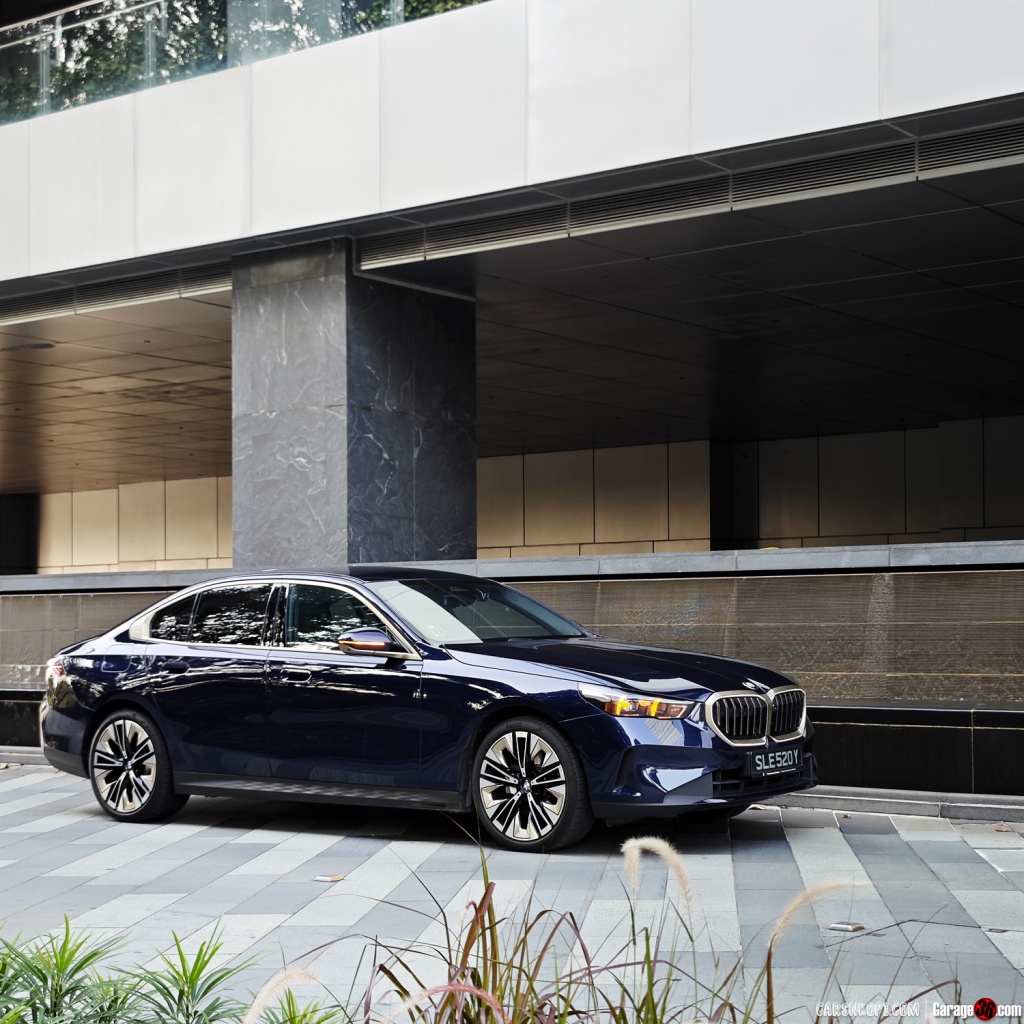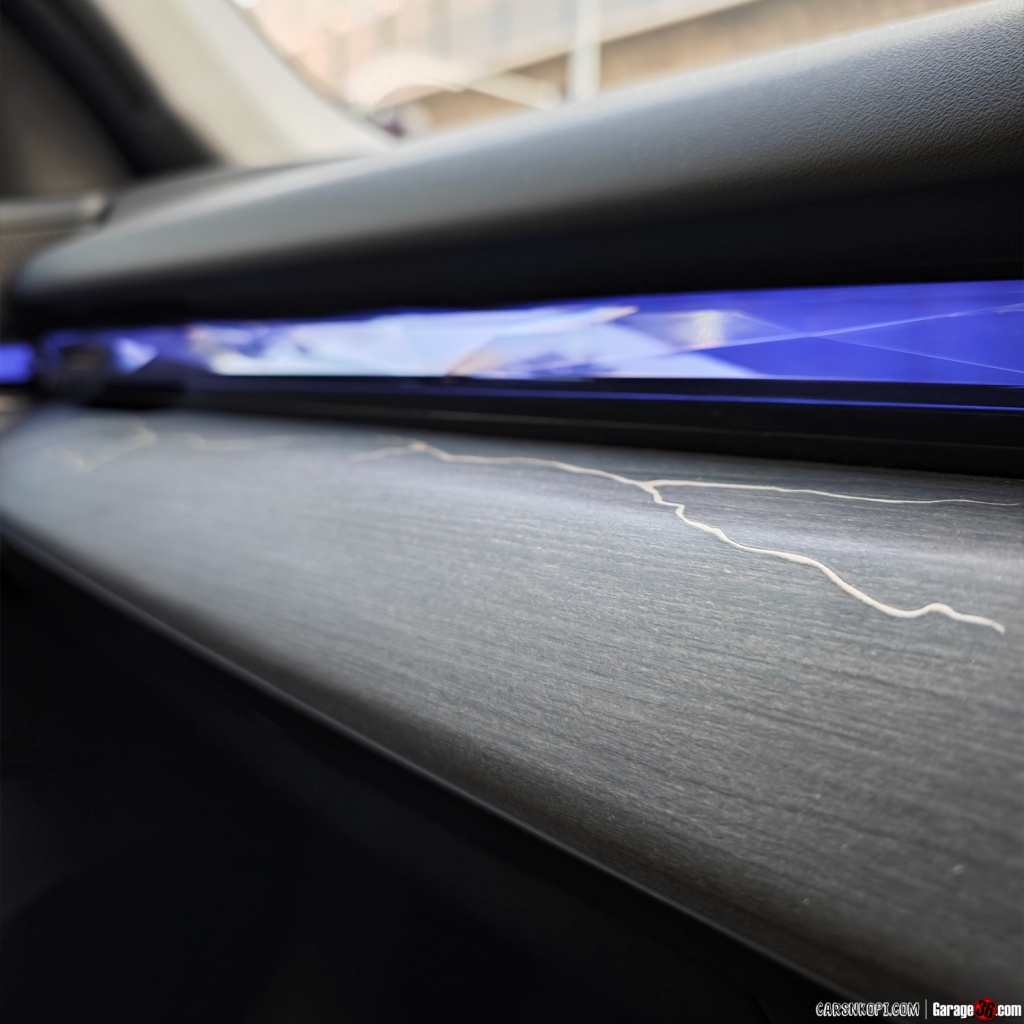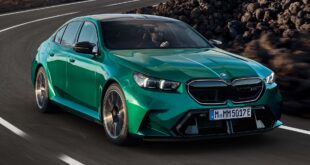You’ve been keeping up with our reviews, you’re already familiar with our recent experience behind the wheel of the BMW i5, representing the electric variant of BMW’s eighth-generation 5 Series. Now, we shift gears to explore the other side of the spectrum with the 520i, powered by conventional fossil fuel (albeit with a mild hybrid configuration). Similar to its electric counterpart, the i5, the 520i rides on the Cluster Architecture (CLAR) platform, which it shares with the G70 7 Series. This not only makes it significantly larger than its predecessors but also the most technologically advanced model in its lineage.
An abundance of cutting-edge technology may catch the eye of casual onlookers, but true aficionados know that the latest gadgets and gizmos alone don’t define a great car—especially when it bears the iconic 5-Series nameplate. So, in the spirit of progress, let’s journey back about 50 years into the early 70s to gain some perspective.

Amidst the turbulence of BMW’s early years, the call for a new model to succeed their esteemed Neue Klasse saloon cars emerged as a beacon of necessity and innovation. After a decade of loyal service, these cars signaled the imperative for a modern successor to propel BMW forward. Yet, this task was no small feat, as the Neue Klasse not only pulled BMW back from the brink of bankruptcy but also laid the very foundation for its resurgence. It became an emblem of the brand’s resilience and pioneering spirit, symbolizing not just a vehicle but an entire era of BMW’s enduring legacy, something its successor had to honour and carry forward. Thus, the BMW 5 Series was born.
The brief, was simple. The new 5 Series would serve as a vital connection between BMW’s sporty 02 and their luxurious New Six, the precursor to the 7 Series. It would introduce a mid-size sedan seamlessly blending performance and comfort, to a growing market of drivers seeking both qualities. It would feature a chassis capable of delivering a unique driving experience thanks to cutting-edge technological and engineering advancements. And, with Paul Bracq at the helm of design, it would feature an exterior design striking the perfect balance between sportiness and elegance. It would, in short, be a truly exceptional automobile that would become a leader in the mid-size luxury segment.
I suppose it goes without saying that, eight generations later, the BMW E12 5 Series, which made its debut in 1972, not only fulfilled its development objectives but also surpassed the legacy of the Neue Klasse.



The development story is significant in this instance because while I do enjoy bits of geeky automotive history, the basis of the original car has remained unchanged 50 years on. Despite the evolution of automotive technology and design trends, the fundamental DNA of the 5 Series has remained unchanged even with the G60, so let’s begin.

Too busy to read everything? Here are the 5 key takeaways for the BMW G60 520i
- Just like the i5 we tested recently, the 520i is built on an updated version of the rear-wheel drive Cluster Architecture (CLAR) platform shared with the larger G70 7 Series. Making it significantly larger than its predecessors.
- Apart from the all-electric i5, this Mild Hybrid 520i is currently the only combustion-engined variant of the 5 series available locally with no concrete plans to bring in the 530i, 530e, 540i, 550e or any of the diesel-powered models.
- Power figures for the 520i stand at 190 horsepower and 310Nm of torque. Allowing for a 0-100km/h acceleration time of 8.1 seconds. Making it unusually slower than its rival from Stuttgart which hits the same speed in 7.5 seconds with its 201 horses and 320Nm. However, fuel consumption figures for both cars are identical, with manufacturers quoting 14.3 km/L.
- Dynamically, the 520i not only surpasses its slightly heavier rival (1,800kg against 1,825kg) but also manages to feel much lighter on its feet than its i5 stablemate An achievement undoubtedly aided by having to manage 405 kilos less.
- At the time of writing, the standard G60 520i retails for S$340,888 while the M Sport variant with its enhanced aesthetics and larger wheels, lists for S$348,888. Significantly undercutting their Stuttgart E200 rival by around S$40,000. Incidentally, Mercedes-Benz’s pricing strategy now places their petrol-powered E200 directly in contention with the i5.

Performance and comfort
Built upon the updated rear-wheel drive Cluster Architecture (CLAR) platform shared with the larger G70 7 Series, the latest 5 Series (chassis code G60) not only has the longest wheelbase in its class, it also features increased track widths at both the front and rear axles, achieving an almost perfectly balanced 50 : 50 ratio axle load distribution through the use of intelligent lightweight construction and increased body and chassis connection rigidity. Its advanced chassis control systems, have been model-specifically adapted to the weight balance associated with each respective drive technology, directly affecting a torque vectoring system for wheel slip limitation, integrated braking systems and variable steering ratios.

While the technical details may sound like alien techno-jargon, what they translate to is a driving experience in our 520i that surpasses even its i5 sibling. With over 400 kilograms less weight to manage (1,800kg compared to 2,205kg), our 4-cylinder engine-powered 520i felt noticeably more agile. Paired with the 5 Series’ direct and sharp steering, it navigated through tight corners with impressive nimbleness and responsiveness. However, the experience could have been further elevated if more feedback was provided through the same steering that even on its sportiest setting didn’t communicate as much as I’d like.

With the 520i Mild Hybrid variant being the sole powertrain option available in Singapore, the absence of outright firepower is indeed noticeable. As the revs climb towards the upper range, the 520i’s 190 horses begins to taper off, prompting one to wonder why BMW Asia didn’t also introduce the 530i. Having driven the 330i Touring fitted with the same engine that produces a more enticing 255 horses and 400Nm of torque, a 530i would have hit the sweet spot in terms of power and weight, offering a much more rewarding driving experience. However, despite the modest power figures, the 520i proves punchy enough to pull ahead during the occasional traffic light sprint, thanks to its 310 Newton Metres of accelerative force. While not the most entertaining of powertrains, it feels lively enough and should suffice for most owners.
One thing that doesn’t rely on firepower is ride comfort. Despite the 520i’s passive suspension setup (featuring a non-active double-wishbone front suspension on coil springs and multilink rear suspension on air springs), the ride strikes a balance between sporty dynamics and luxurious comfort typical of the best-sorted BMWs. It smooths over uneven surfaces with grace and ease, although occasional hard bumps may still be felt, presenting a ride that pips even that of the i5, no doubt aided by the 520i’s weight advantage and softer springs. Additionally, noise insulation is top-notch, surpassing even the latest 7 Series, which is plagued by annoying A-Pillar wind buffeting at high speeds (unless equipped with double-glazed windows, of course).

So, top-notch performance and comfort derived from a chassis capable of delivering a unique driving experience thanks to cutting-edge technological and engineering advancements? Check!
A sporty and elegant design

With the G60 sitting on the aforementioned CLAR platform, it’s not surprising that it is the largest the 5 Series has ever been. With the G60 sitting on the aforementioned CLAR platform, it’s not surprising that it is the largest the 5 Series has ever been. The dimensions reflect this expansion, with the length increasing by 97 millimetres to 5,060 millimetres, the width growing by 32 millimetres to 1,900 millimetres, and the height rising by 36 millimetres to 1,515 millimetres. Additionally, its wheelbase has been extended by 20 millimetres to 2,995 millimetres.

Beyond its numerical dimesions though is a body style that radically departs from its evolutionary predeccessors. Featuring a more upright visage with larger, bolder surfaces, strong and deliberate geometrical shapes and even stylistic cues to not just the latest Neue Klasse Concepts but also the original E12 5 Series.

That said, while our 520i test car does look quite handsome, it’s worth noting that it was outfitted in a unique “Launch Edition” trim, limited to just ten units. This special package boasts bronze titanium (gold) accents, larger 20″ wheels, and distinctive interior trim panels inspired by the Japanese Kintsugi art of repairing pottery with Urushi lacquer mixed with powdered gold, silver, or platinum. Standard models come with silver trim, 19″ wheels, and a more understated interior featuring dark oak wood trim. Opting for the M Sport package (an S$8,000 option) adds redesigned bumpers, side skirts, shadowline trim, and 20″ wheels. Inside, you’ll find dark silver M accents and aluminium rhombicle trim pieces. While the M Sport springs may not suit everyone’s driving preferences, the enhanced aesthetics offered by the M Sport package are definitely worth considering if the “Launch Edition” is no longer available.

An exterior design striking the perfect balance between sportiness and elegance? While it does look rather underwhelming in base standard trim, the “Launch Edition” and M Sport cars significantly redeem the aesthetics. So, I’d say it’s a go.
What about the interior?

Step inside, and you’ll discover a fusion of high-tech electronic features, premium materials, and expert craftsmanship. BMW has excelled in prioritizing material quality over flashy oversized screens. Space is, of course, abundant in a BMW of this segment, especially one that has grown in size with a new platform. Leg, knee, and headroom for 4-5 adults are generously catered for, with comfortably supported seats for both occupants up front.

The interior is enveloped in a synthetic leatherette named “Veganza,” offering a soft texture and cool-to-the-touch surfaces that exude luxury and refinement, surpassing even the feel of real leather found on many mainstream vehicles. Those fortunate enough to take the wheel of a G60 will also be treated to its 12-speaker Harman Kardon sound system, capable of filling the interior with 205 watts of auditory delight.

Regrettably, like its i5 counterpart, the G60 also falters in certain areas of user interaction. Firstly, the haptic buttons prove challenging to navigate while on the move, requiring precise and purposeful presses to access desired features. However, the most significant drawback lies with the cumbersome and confusing interface of iDrive 8.5, which is poorly arranged and urgently in need of improvement given the massive strides in user experience made not just by its traditional rivals but also those from Korea and China.
Notably, Adaptive Cruise Control with steering assist is unavailable, along with individual climate controls for rear seat passengers. Omissions quite noticeable for a vehicle in this segment.
Putting those gripes aside, and as we eagerly await the arrival of an iDrive 9.0 update, the G60 does an excellent job of elevating the cabin of the 5 Series to a level almost akin to its larger 7 Series sibling. This is especially noticeable with the crystal-like light bar running across the front of the dashboard.
A truly exceptional automobile?

As we delve into the evolution of the BMW 5 Series earlier, it does become fascinating to observe how many of the initial development goals endure today. The core principles of balancing sportiness with luxury, pushing boundaries in technology and design, and prioritizing driving pleasure remain central to the creation of every 5 Series model. From its roots in the Neue Klasse’s legacy to its present-day manifestation on the G60 platform, each iteration of the 5 Series has evolved to redefine luxury and performance in the mid-size segment. Despite some shortcomings, the latest G60 5 Series once again raises the bar on each of its ideals. The very ideals that continue to guide the creation of the 5 Series and a testament to the enduring relevance of BMW’s original vision from over half a century ago. Truly exceptional though? Perhaps if they brought in the 530i.
 BMW.SG | BMW Singapore Owners Community The Ultimate BMW Community – Established Since 2001
BMW.SG | BMW Singapore Owners Community The Ultimate BMW Community – Established Since 2001













